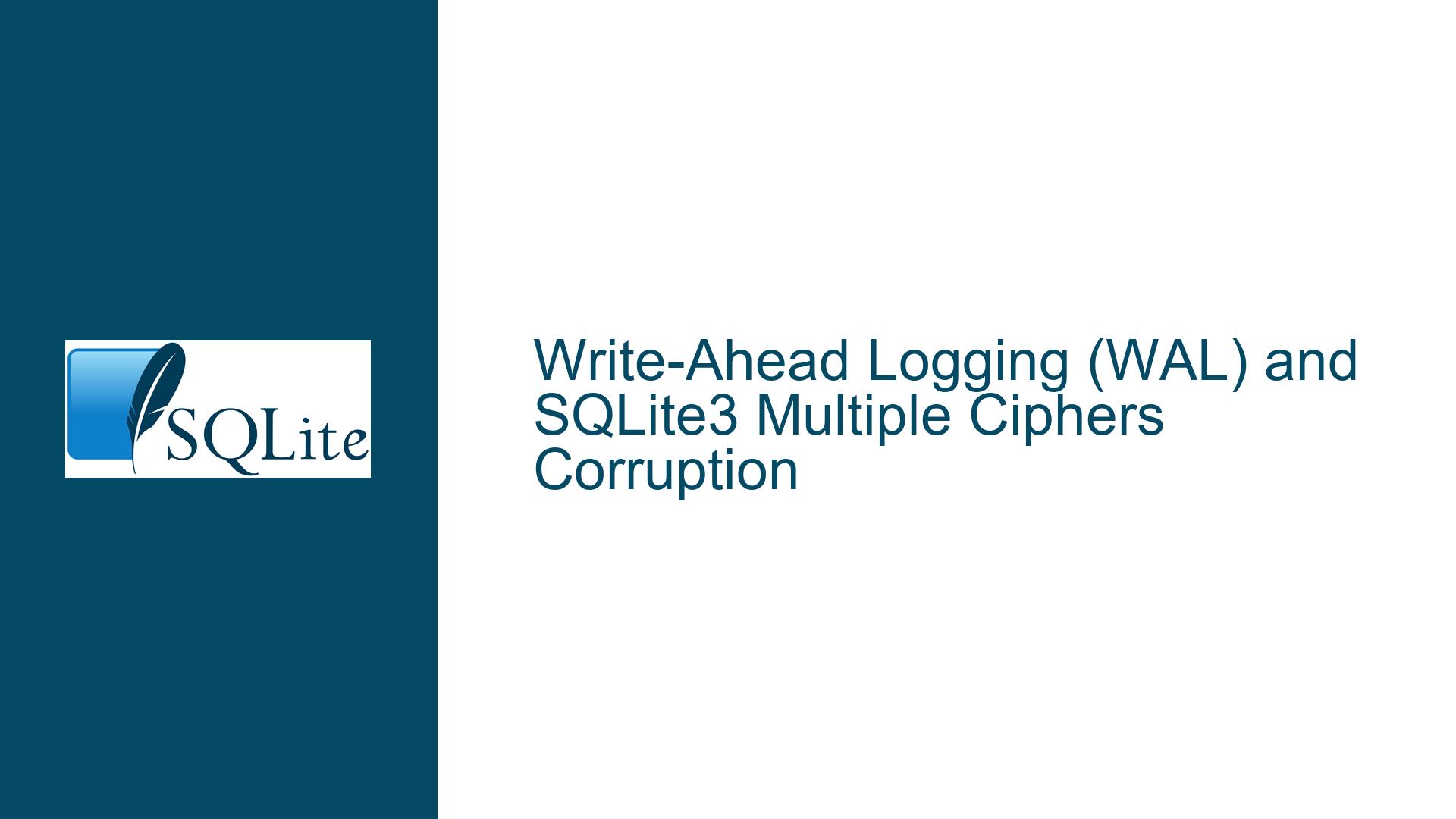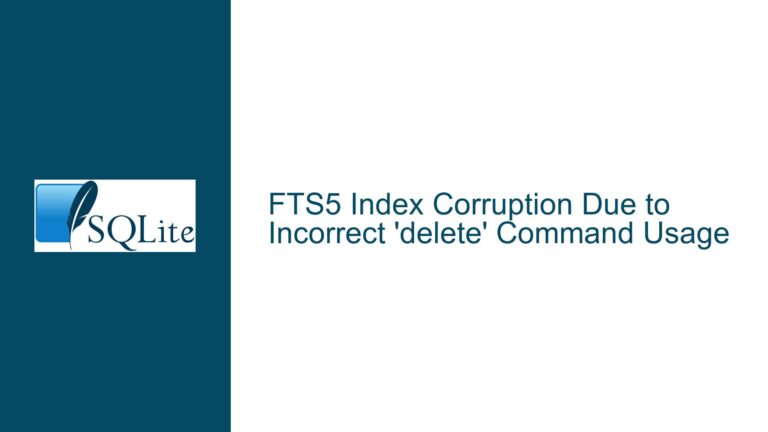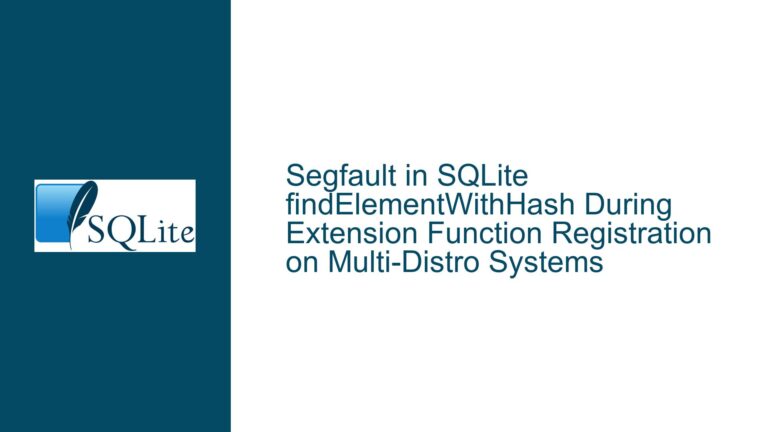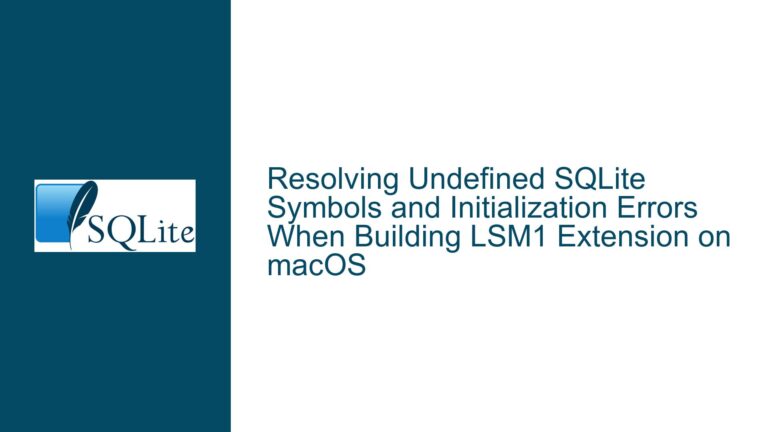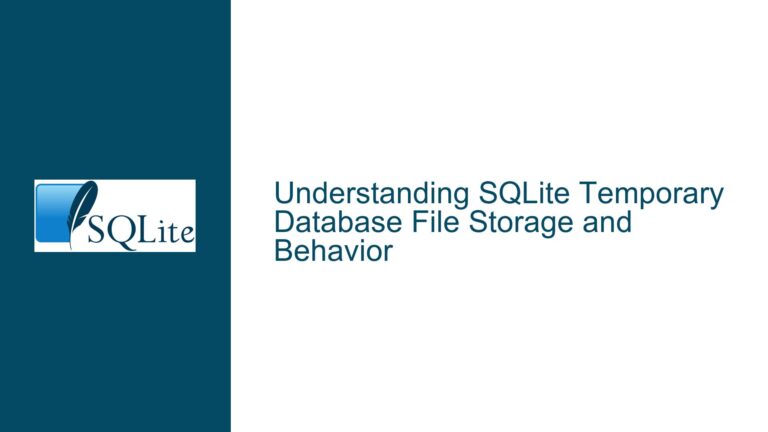Write-Ahead Logging (WAL) and SQLite3 Multiple Ciphers Corruption
Understanding the Impact of Write-Ahead Logging (WAL) with Multiple Ciphers
In the context of SQLite, the interaction between Write-Ahead Logging (WAL) and encryption through SQLite3 Multiple Ciphers presents a unique challenge that can lead to database corruption, particularly following unexpected power failures. This section provides an overview of the issue at hand, detailing how WAL operates, the role of encryption in SQLite databases, and the specific circumstances that lead to corruption.
Write-Ahead Logging (WAL) Explained
Write-Ahead Logging is a logging mechanism used by SQLite to enhance performance and ensure data integrity during transactions. Unlike traditional rollback journal methods, WAL allows for concurrent reads and writes, which significantly improves throughput. In WAL mode, changes to the database are first recorded in a separate WAL file before being committed to the main database file. This means that even if a transaction is interrupted—such as during a power failure—the changes can be recovered from the WAL file upon restart.
However, this mechanism introduces complexity when combined with encryption. When an SQLite database is encrypted using SQLite3 Multiple Ciphers, both the main database file and the associated WAL files are encrypted. The encryption process involves setting specific cipher parameters and passwords through PRAGMA commands.
The Role of Encryption in SQLite
SQLite3 Multiple Ciphers allows developers to choose from various encryption algorithms for securing their databases. This flexibility is beneficial for applications requiring enhanced security; however, it complicates the recovery process after a failure. The encryption settings are typically applied at the time of creating or opening the database using PRAGMA commands. Unfortunately, if these parameters are not correctly set or if they change unexpectedly—such as due to a power failure—the encrypted WAL files may not be accessible or usable when attempting to open the database.
Circumstances Leading to Database Corruption
The core issue arises when a power failure occurs while the database is in WAL mode with multiple ciphers enabled. During such an event, any uncommitted changes stored in the WAL file may become corrupted if they are not properly merged back into the main database file. When attempting to open the database afterward, SQLite encounters difficulties decrypting and merging these WAL files due to potential mismatches in cipher parameters or corruption within the files themselves.
In this specific case discussed in the forum thread, the user reported encountering a corrupted database after a power failure while using an encrypted SQLite database with Write-Ahead Logging enabled. The user suspected that their WAL files were encrypted but were not being handled correctly during the opening process due to missing API support for setting cipher parameters at that time.
This situation highlights several critical factors:
- Encryption Consistency: The need for consistent cipher parameters across both main and WAL files to ensure successful decryption.
- Recovery Mechanism: The importance of having a robust recovery mechanism in place when using WAL mode with encryption.
- Power Failure Risks: The inherent risks associated with relying on power stability when operating databases in WAL mode.
Understanding these nuances is crucial for developers working with SQLite databases that utilize both Write-Ahead Logging and encryption. Proper handling of these elements can prevent data loss and corruption, ensuring that applications remain resilient against unexpected failures.
Analyzing the Risks Associated with Write-Ahead Logging (WAL) and SQLite3 Multiple Ciphers
When utilizing Write-Ahead Logging (WAL) in conjunction with SQLite3 Multiple Ciphers, several potential risks can lead to database corruption. Understanding these risks is crucial for developers and database administrators to implement effective strategies for data integrity and reliability. This section delves into the possible causes of corruption when using WAL with SQLite3 Multiple Ciphers, particularly focusing on power failures, improper synchronization, and encryption-related issues.
Power Failures and Transaction Durability
One of the primary concerns when operating an SQLite database in WAL mode is the risk of data loss during power failures. While WAL is designed to enhance performance by allowing concurrent reads and writes, it does not inherently protect against data loss if a transaction is interrupted before it can be committed to the main database file.
The WAL file serves as a temporary storage for transactions that have been committed but not yet merged into the main database. In the event of a power failure, any uncommitted transactions stored in the WAL file may be lost, leading to incomplete data states in the main database.
To mitigate this risk, it is essential to configure the PRAGMA synchronous setting appropriately. Setting synchronous=FULL ensures that all write operations are synchronized to disk before they are considered complete, significantly reducing the risk of corruption during abrupt shutdowns. However, this comes at the cost of performance, as each write operation incurs additional disk I/O overhead.
Improper Synchronization Between Processes
When multiple processes or threads access an SQLite database concurrently, particularly in WAL mode, improper synchronization can lead to corruption. SQLite allows multiple readers to access the database simultaneously; however, only one writer can modify the database at any given time. If two processes attempt to write to the database concurrently without proper coordination, it can result in a corrupted state.
The underlying issue often lies in how SQLite handles file locking. SQLite employs POSIX advisory locks on Unix-like systems to manage access between concurrent processes. However, these locks can be bypassed if another thread or process accesses the database file directly without going through the SQLite library. This scenario can lead to situations where one process’s operations inadvertently disrupt another’s ongoing transactions.
To prevent such conflicts, developers should implement a robust inter-process communication mechanism that orchestrates write operations among processes. This could involve using mutexes or semaphores to ensure that only one process can write to the database at any time while allowing multiple processes to read concurrently.
Encryption Challenges with Multiple Ciphers
Using SQLite3 Multiple Ciphers introduces additional complexity due to encryption parameters that must be consistently applied across both the main database and WAL files. Each cipher scheme may have different requirements regarding how keys and parameters are set during database operations.
If there are discrepancies in encryption settings—such as using different ciphers or keys for the main database file and its associated WAL files—this can lead to decryption failures when attempting to open the database after a crash or power failure. In such cases, even if the main database file remains intact, the inability to correctly decrypt WAL files can render them useless, ultimately leading to data loss.
Developers must ensure that encryption parameters are consistently applied throughout their application’s lifecycle. This includes setting cipher parameters using PRAGMA commands prior to opening or creating databases and ensuring that these settings are adhered to during all read and write operations.
Conclusion
The combination of Write-Ahead Logging and SQLite3 Multiple Ciphers offers significant performance benefits but also introduces several risks that can compromise data integrity. Power failures can lead to uncommitted transactions being lost; improper synchronization between concurrent processes may result in corruption; and inconsistencies in encryption settings can hinder access to critical data stored in WAL files.
To safeguard against these issues, it is vital for developers and database administrators to implement best practices such as configuring synchronous settings appropriately, coordinating access among multiple processes, and maintaining consistent encryption parameters across all components of their SQLite databases. By addressing these potential pitfalls proactively, users can leverage the advantages of WAL and encryption while minimizing risks associated with data corruption.
Implementing Solutions for Write-Ahead Logging (WAL) and SQLite3 Multiple Ciphers
To effectively address the challenges posed by using Write-Ahead Logging (WAL) in conjunction with SQLite3 Multiple Ciphers, various troubleshooting steps and solutions can be implemented. These solutions focus on enhancing database stability, ensuring proper encryption management, and optimizing performance while minimizing the risk of corruption. This section outlines practical approaches to mitigate issues related to WAL and SQLite3 Multiple Ciphers.
1. Configuring WAL and Checkpointing
One of the primary strategies for preventing WAL file corruption is to ensure that the checkpointing process is correctly configured. Checkpointing is the mechanism through which changes recorded in the WAL file are merged back into the main database file. Proper management of checkpoints can significantly reduce the risk of uncommitted transactions leading to corruption.
To configure checkpointing effectively, developers should consider the following:
Automatic Checkpointing: By default, SQLite automatically checkpoints when the WAL file exceeds a certain size (1000 pages). Developers can adjust this threshold using the
PRAGMA wal_autocheckpointcommand to define a more suitable size based on application needs. For instance, setting a smaller threshold may help maintain a manageable WAL size during high transaction volumes.Manual Checkpointing: In scenarios where automatic checkpoints are insufficient, developers can implement manual checkpointing using
PRAGMA wal_checkpoint. This command allows for explicit control over when checkpoints occur, providing opportunities to merge changes during periods of low database activity.Monitoring WAL Size: Implementing a monitoring mechanism to track the size of the WAL file can help prevent excessive growth. If the WAL file exceeds a predefined size, developers can trigger manual checkpoints or pause write operations temporarily to allow for checkpoint completion.
2. Ensuring Consistent Encryption Parameters
When using SQLite3 Multiple Ciphers, it is critical to maintain consistent encryption parameters across both the main database and its associated WAL files. Any discrepancies in cipher settings can lead to decryption failures and potential data loss. To ensure consistency:
Set Encryption Parameters at Open Time: Use URI parameters to specify encryption settings when opening the database. This approach allows developers to define cipher schemes and keys directly in the connection string, ensuring that all connections adhere to the same encryption configuration.
Implement Secure Key Management: Securely managing encryption keys is vital for maintaining data integrity. Developers should avoid hardcoding keys in application code; instead, utilize secure storage solutions such as environment variables or dedicated key management services (KMS). This practice minimizes exposure to unauthorized access and enhances overall security.
Regularly Update Encryption Libraries: Keeping libraries such as SQLCipher up-to-date ensures that any security vulnerabilities are addressed promptly. Regular updates also provide access to new features and optimizations that can enhance encryption performance.
3. Implementing Robust Error Handling
Incorporating robust error handling mechanisms within applications that utilize SQLite databases in WAL mode is essential for maintaining data integrity and user experience. Applications should be designed to gracefully handle potential errors related to database access and operations:
Connection Management: Ensure that all database connections are properly opened and closed using
sqlite3_close()after operations are completed. This practice helps prevent lingering connections that could interfere with checkpoint processes or lead to corrupted states.Transaction Management: Implement transaction management best practices by using
BEGIN,COMMIT, andROLLBACKstatements appropriately. This ensures that changes are only committed when all operations succeed, reducing the likelihood of partial writes that could corrupt the database.Error Logging: Integrate logging mechanisms to capture errors encountered during database operations. Detailed logs can assist developers in diagnosing issues related to WAL file recovery or encryption failures, allowing for timely resolutions.
4. Optimizing Application Architecture
The architecture of applications interacting with SQLite databases should be optimized for performance and reliability when using WAL mode:
Reader/Writer Gaps: To facilitate successful checkpointing, applications should be designed to create "reader gaps"—periods during which no read operations occur while write transactions are being processed. This approach allows checkpoints to complete without interference from active readers.
Concurrency Management: Properly manage concurrency by ensuring that only one writer accesses the database at any given time while allowing multiple readers. Utilizing appropriate locking mechanisms can help prevent conflicts between concurrent operations.
Load Balancing: In high-load scenarios, consider implementing load balancing strategies where write operations are distributed across multiple instances or servers. This can help alleviate pressure on a single database instance, reducing the likelihood of excessive WAL growth due to high transaction rates.
Conclusion
By implementing these solutions—configuring checkpointing effectively, ensuring consistent encryption parameters, incorporating robust error handling, and optimizing application architecture—developers can significantly mitigate risks associated with using Write-Ahead Logging in conjunction with SQLite3 Multiple Ciphers. These strategies will not only enhance data integrity but also improve overall application performance and reliability in handling encrypted SQLite databases.
